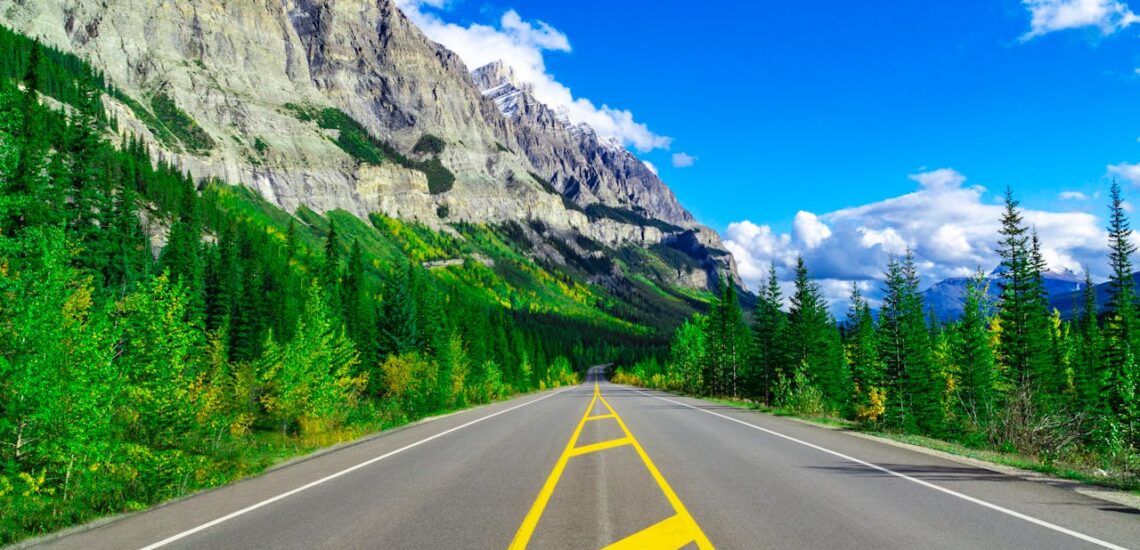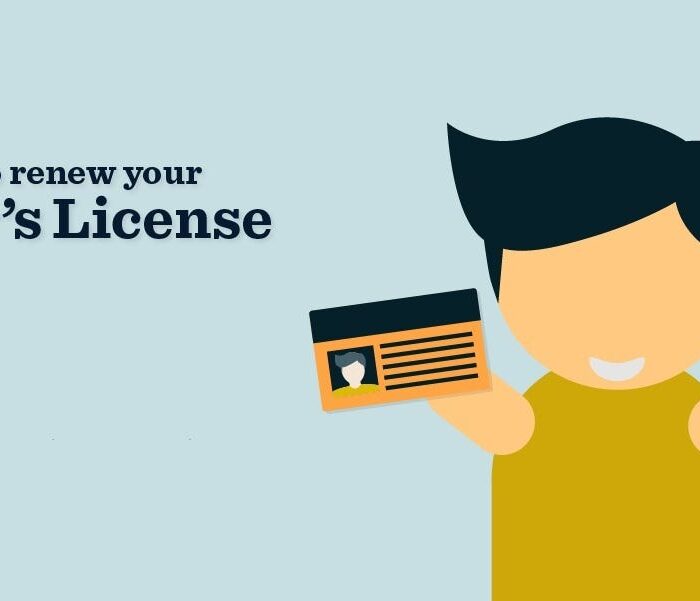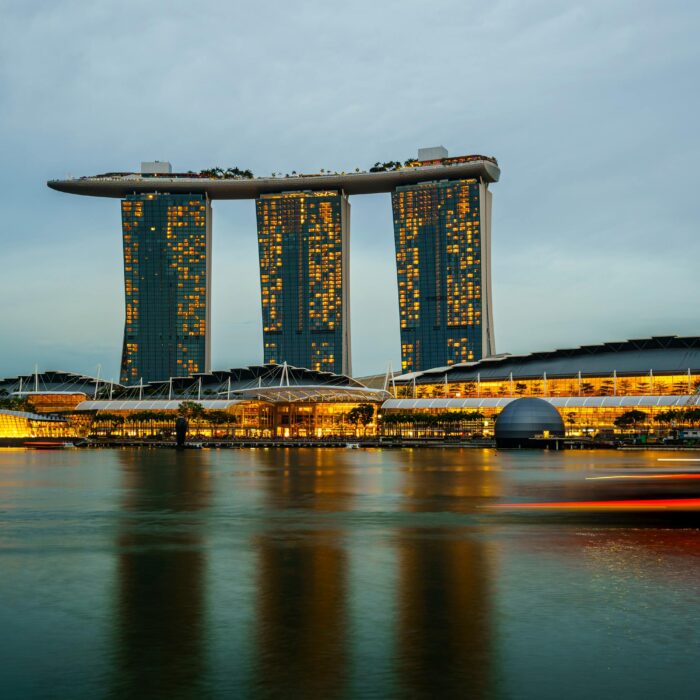Nord und groß, Kanada ist dennoch kein Land, in dem die verschiedenen Regionen — die Vororte und das Zentrum — getrennt sind. Unter den Verkehrswegen nimmt das Straßennetz einen würdigen Platz ein — die Länge von Autobahnen, Fahrstraßen und Feldwegen beträgt 1,042 Millionen km, von denen 27.63 tausend km Bundesstraßen sind. Nur in Kanada gibt es 415,6 tausend km Straßen mit einer Abdeckung (40%), aber noch 60% der öffentlichen Straßen hat keine Abdeckung, und das ist 626,7 tausend km.
Lassen Sie uns versuchen, die kanadischen Straßen aus der Perspektive einer Person zu charakterisieren, die diesen Staat aus dem Autofenster kennen lernen möchte.
Qualität
Im Durchschnitt dient die Asphaltdecke auf kanadischen Straßen fast 18 Jahre, danach wird sie komplett gewechselt. Wo harte Winterbedingungen herrschen, gibt es provisorische Strecken für schwere Forstmaschinen und Wintersportler. So befinden sich die meisten Autobahnen in Kanada im Süden —entlang der amerikanischen Grenze — und das sind fast 80% des Straßennetzes. Es stellt sich heraus, dass die kanadischen Autobahnen in fünf Provinzen konzentriert sind — Saskatchewan, Alberta, Quebec, Ontario und British Columbia.
Die neue Brücke, die in Kanada gebaut wird, sollte 75 Jahre dauern, dann wird sie komplett geändert. Und alte Brücken werden alle 25-40 Jahre repariert, bis neue gebaut werden.
Die Kanadier sparen nicht an der Wartung von Autobahnen: jährlich werden 400 Millionen Dollar für diese Zwecke bereitgestellt. Jahrhunderts wurde das “Strategische Programm zur Entwicklung der Infrastruktur der Straßen” (SHIP) umgesetzt, das den kanadischen Steuerzahlern 600 Millionen Dollar kostete.
Der Zustand der kanadischen Straßen variiert stark je nach Jahreszeit. Nach dem Winter können viele Schlaglöcher aussteigen. Aber die Grübchenreparatur ist sehr schnell und aktiv. Im April und Mai werden wegen der Arbeiten oft Straßen gesperrt, die Bürger müssen jeden morgen die Internetseite der Stadtverwaltung überprüfen, um nicht auf langwierige Umwege zu stoßen. Während der Reparatur wird ein Streifen blockiert, dieser Ort wird durch zahlreiche Lichter und Zeichen gekennzeichnet. Im Voraus auf dem Weg ist immer ein Fahnder oder Polizist. Das Flaggschiff regelt die Fahrt durch den Arbeitsbereich, und theoretisch Ungehorsam es bringt die gleiche Strafe, wie im Falle der Ungehorsam Regulator.
Die Verantwortung
Die meisten kanadischen Straßen werden von Provinzen und Territorien geführt. Ein kleiner Teil des Straßennetzes ist privat und kostenpflichtig (aber es gibt nur wenige solche Autobahnen und Sie sind alle im Großraum Toronto konzentriert). Die Bundesregierung nimmt dennoch bestimmte Funktionen nicht auf und löst folgende Aufgaben:
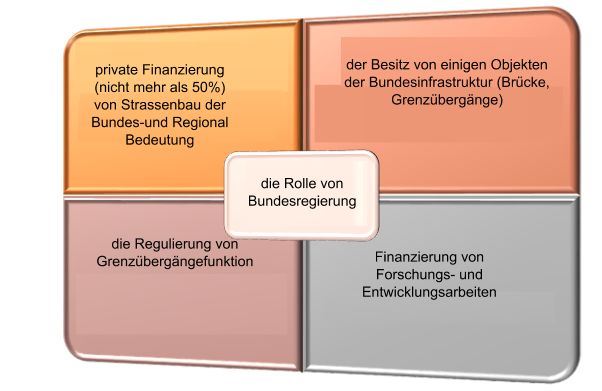
Trans Canada Highway system führt durch ganz Kanada von St Johns, Newfoundland, nach Vancouver in British Columbia, seine Gesamtlänge beträgt etwa 7.8 tausend km. Genau diese Entfernung muss ein Fahrer überwinden, der Kanada von Küste zu Küste fahren will. Das ist etwa 800 km mehr als die Entfernung von Minsk nach Toronto mit dem Flugzeug. Die transkanadische Autobahn ändert jedes mal die Nummer bei der Einfahrt in eine andere Provinz.
Sicherheit
Die Sicherheit auf den Landstraßen ist gut genug. Die Straßenränder sind sehr breit (sowohl Links als auch rechts), und jeder Rand der Straße hat einen sogenannten rumble strip — ein Streifen in Form einer Waschplatte, bei der Ankunft auf die das Auto beginnt zu schütteln. Es wird speziell gemacht, damit der Fahrer versteht: Räder werden jetzt von einer Deckung herabkommen. Außerdem hilft ein Streifen, einen eingeschlafenen Autofahrer zu wecken.
Bereits Anfang 2006 wurden in Kanada änderungen, die die Sicherheitsanforderungen verschärfen, an das Bundesgesetz über den Straßenverkehr (Motor Vehicle Transport Act), das das Hauptdokument für den Straßenverkehr ist, verabschiedet. Zu den wichtigsten Dokumenten gehören auch die Regeln für die Zertifizierung der Sicherheit im Straßenverkehr (Motor Carrier Safety Fitness Certificate Regulations) und die Regeln für die Arbeitszeit (Hours of Service Regulations) — für den Fernverkehr im Güter-und Busverkehr.
Seit dem 1. Januar 2007 gelten neue Regeln für die Dauer des Arbeitstages (Commercial Vehicle Driver’s Hours of Service Regulations) für Langstrecken LKW-und Bus-Verkehr. Um Verkehrsunfälle zu reduzieren, Regeln die Regeln die Regeln der Erholung der Fahrer und betreffen Lastwagen mit einem Gesamtgewicht von 4 500 kg und höher, sowie Busse mit einer Kapazität von 10 Passagieren und höher, einschließlich des Fahrers.
Der Straßenverkehr in Kanada wird von Speditionsunternehmen (For-Hire motor carriers), industriellen Transportunternehmen, individuellen Transportunternehmen und Kurierdiensten durchgeführt. Je nach Art der Beförderung befinden sich die Betreiber in der Zuständigkeit der Provinzbehörden (wenn Sie in einer Provinz tätig sind) oder der Bundesbehörden (wenn Sie interprovinciale Beförderungen durchführen).
Die Speditionsunternehmen fungieren als Agent zwischen dem Kunden und dem Systembetreiber und spezialisieren sich hauptsächlich auf bestimmte Arten von waren (Flüssigkeiten, Holz, Konsumgüter, etc.). Sie führen etwa 45% der straßengütertransporte aus, deren Großteil auf interprovinciale Transporte entfällt. In Kanada gibt es etwa 10,000 Speditionsunternehmen, die größten von ihnen zählen von 4 bis 12 tausend Einheiten der Technik (Lastwagen, Anhänger und Auflieger). Rund 80,000 Lastwagen gehören zu ihnen, weitere 45,000 gehören den einzelnen Trägern, die mit ihnen im Mietvertrag arbeiten.
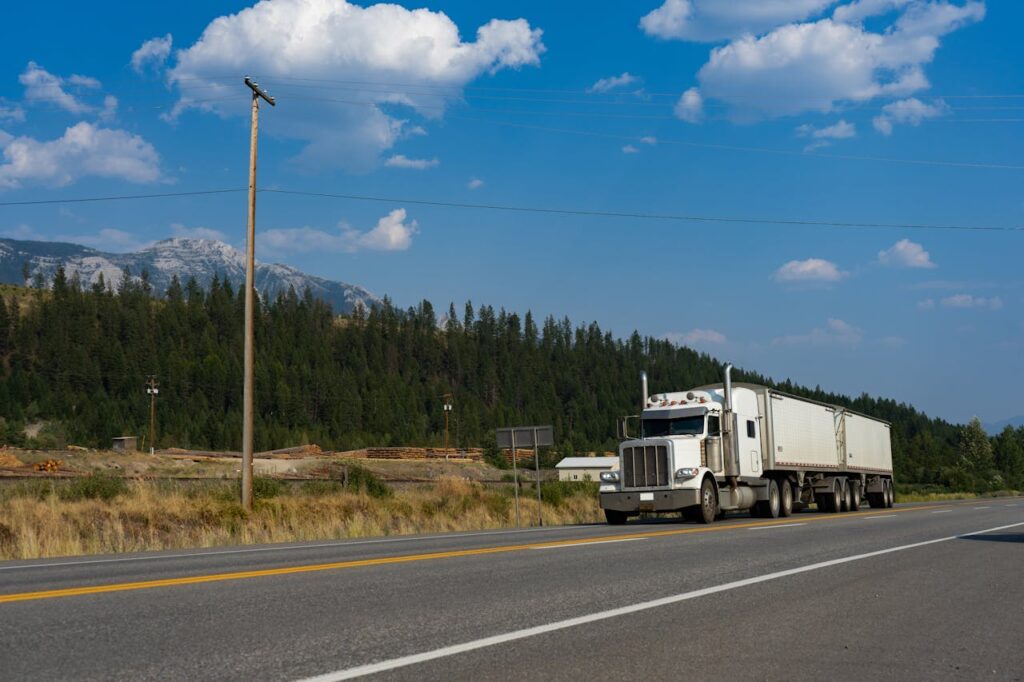
Bei einzelnen Spediteuren ist der Eigentümer selbst LKW-Fahrer, nimmt Bestellungen unabhängig von Speditionsunternehmen an und bearbeitet sie, stellt die Beförderung von waren für den Absender oder die Speditionsgesellschaft sicher. In Kanada gibt es etwa 36,000 einzelne Carrier.
Industrieträger bieten hauptsächlich den Transport von Produkten des Unternehmens (Hersteller von Lebensmittelprodukten, etc.). Hauptsächlich verwenden Lastwagen der mittleren Tonnage (mit einer Tragfähigkeit von nicht mehr als 15 T) und führen lokale Transporte auf kleinen und mittleren Entfernungen durch.
Kurierdienste im Straßenverkehr bieten hauptsächlich die lokale Lieferung von Paketen und/oder waren in kleinen Mengen. Der Jahresumsatz der Kurierdienste wird auf 6 Milliarden US-Dollar geschätzt. Die gesamte LKW-Flotte überschreitet nicht 2,000 Einheiten. Kurierdienste verwenden hauptsächlich Transporter und PKW.
Da es in Kanada eine gesetzliche Alkoholgrenze von 0.8 Promille gibt, kann man leicht (aber ganz leicht) fahren!). Ausnahme-Alter bis 21 Jahre-Jungen Fahrern ist das Trinken am Steuer generell verboten.
Wenn die Alkoholmenge 0.8 Promille überschritten hat, wird sofort eine Strafanzeige gestellt. In der Provinz Ontario ist es für bis zu $1 Tausend Geldstrafe, Entzug von einen Führerschein bis zu zwei Jahren, sowie die obligatorische Passage des Programms back on track. Es ist ein Bildungsprogramm, in dem fast einen Monat erklären, warum es nicht gut ist, am Steuer zu trinken. Nachdem Sie dieses Programm durchlaufen und Ihr Führerschein zurückgegeben haben, muss der Täter noch ein Jahr mit einem speziellen ignition interlock — Gerät fahren — einem Computer mit einem atmungssensor. Jedes Mal, um den Motor zu starten, muss er in die Röhre Blasen. Wenn Alkoholdämpfe festgestellt werden, wird das Auto nicht gestartet. Hinter dem Lenkrad anderer Autos, die nicht mit interlock ausgestattet sind, kann man sich in dieser Zeit nicht setzen.
In Kanada gibt es eine CAA (Canadian Automotive Association). Es bietet Dienstleistungen wie “Zigarettenanzünder”, wenn die Batterie gesägt, Radwechsel, Öffnung der verschlossenen Tür, ziehen Sie das festsitzende Auto, Abschleppen in einer Entfernung von bis zu 360 km. Hilfe rufen kann man viermal im Jahr kostenlos. Der jährliche Mitgliedsbeitrag beträgt $ 180-200. Dieser Betrag deckt die Kosten für Hotel, Verpflegung und Mietwagen für bis zu drei Tage, wenn ein Vereinsmitglied aufgrund einer Panne auf dem Weg feststeckt.
Bei einer offiziellen Geschwindigkeitsbegrenzung von 100 km/h schreibt die Polizei keine Bußgelder für überschreitungen von bis zu 130 km/h aus. Aber derjenige, der über die Norm von 50 km/h und mehr verstreut ist, erhält eine riesige Geldstrafe ($2-10 tausend) und Entzug von einem Führerschein für bis zu zwei Jahren mit einer Gefängnisstrafe von bis zu sechs Monaten oder ohne ihn.
Personenverkehr
Bus-Personenverkehr in Kanada ist in vier Arten unterteilt: Stadtbusse, Reisebusse, Schulbusse, Charters und Eilbusse. Industrie Personenbeförderung mit mehr als 1,500 Unternehmen, die jährlich tragen mehr als 1.5 Milliarden Menschen. Fernbusse verbinden fast alle kanadischen Provinzen und Territorien mit Ausnahme von Nunavut, wo die Autobahnen aufgrund der geografischen Lage (der Hauptteil — die Inseln des kanadischen arktischen Archipels) praktisch fehlen.
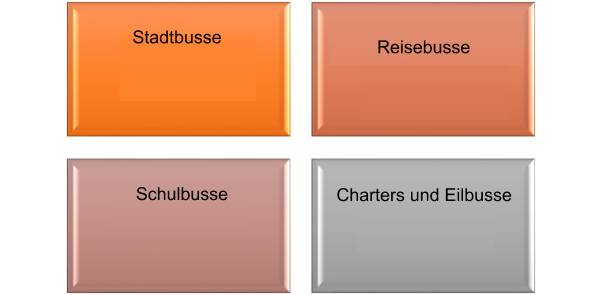
Schulbustransporte bieten die Lieferung von Schülern an Schulen, Hochschulen, Universitäten. Ein Teil der Bildungseinrichtungen enthält eine eigene Flotte von Schulbussen, aber die meisten arbeiten unter einem Mietvertrag mit spezialisierten Unternehmen.
Charters, Eilbusse und touristische Dienstleistungen werden von spezialisierten Unternehmen, privaten Fluggesellschaften, sowie anderen Betreibern (Hotels, Flughäfen, etc.) durchgeführt.
Autobahnservice
Kanada ist eines der führenden Länder in der Entwicklung des Straßendienstes. Der Straßendienst wird von Zentren Namens OnRoute vertreten, die einen Pavillon für Erholung und Verpflegung, Toiletten sowie einen Laden und eine Tankstelle umfassen. Erinnerungen an die Annäherung an ein solches Zentrum beginnen etwa 20-30 km, und die Ankunft ist deutlich mit einem Zeichen gekennzeichnet. Der Güter — und Personenverkehr wird auf verschiedene Parkplätze umgeleitet.
Die Fahrt mit dem Auto führt zum Eingang des Servicezentrums. Im inneren befinden sich Fast-Food-Läden, ein Geldautomat und ein Stand mit Gebäck. Toiletten für 20 Besucher stehen am Eingang. In der Nähe der Waschbecken gibt es einen Platz, um die Windel des Babys zu ersetzen, einen Wasserhahn mit Trinkwasser für Haustiere. Weiter auf dem Weg — tanken. Daneben steht ein Ladenlokal und Selbstbedienungssäulen. An solchen Tankstellen ist Benzin immer teurer (5-7 Cent pro Liter) als in der Stadt.
Kanada ist ein malerisches Land. Es gibt viele Sehenswürdigkeiten. Die Einhaltung der Verkehrsregeln ist jedoch auch in Kanada notwendig. Wir erinnern Sie daran, dass das beim Fahren muss man einen internationalen Führerschein haben. Vergessen Sie auch nicht, dass auf unserer Website können Sie einfach und schnell einen internationalen Führerschein abfassen. Es kostet nicht viel Zeit und Mühe, aber das hilft Ihnen bei der Geländefahrt nicht nur an jedem Ende des Planeten.


Veröffentlicht Dezember 03, 2018 • 8 m zum Lesen

